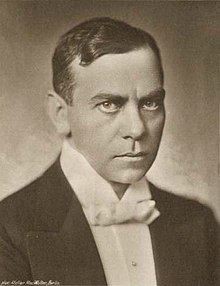Gerhard Dammann (actor)
Gerhard Dammann (born June 30, 1883 in Cologne , † February 21, 1946 in Bad Ischl ; born Heinrich Gerhard Dammann ) was a German actor and comedian .
Life
He left school at the age of fourteen and became an acrobat on variety stages. In this function he crossed Europe and came to Africa and America. At times he was a member of the Hans Hansen Trio. He found access to film around 1907, and from 1913 he was permanently in front of the camera in Berlin.
Dammann has appeared in a large number of silent films, many of which, however, were very short. He was the center of attention as “Bumke” and from 1913 as “Luny” and shone with his acrobatic and grotesque-comic abilities. Most of the time he directed it himself.
From 1914 to 1916 he was a soldier on the Eastern Front, after which he created the figure of "Schnurzel" with his wife Hansi Dege. In 1917 Dammann founded his own production company. From 1923 he appeared under his real name as "Gerhard". In addition to directing and producing, he was also responsible for the script several times.
Dammann also directed the only film operetta “Das Caviar-Mäuschen” (1919) made according to the Lloyd Lachmann method.
Since the mid-twenties, however, there was considerable competition in German cinemas when American comedians became known. In 1925 his company stopped production. In the following two decades, Dammann had to be content with batch roles in German feature films, as he was mostly unnamed as a comic fat man and often appeared briefly several times. In total, Gerhard Dammann appeared in over 350 films.
Filmography (selection)
- 1911: The treacherous ink stain (director and actor)
- 1911: A drama with a neighbor
- 1911: Little Elschen's Easter dream
- 1911: puppets
- 1911: Student love
- 1911: Who is the happiest of the three? (Director and actor)
- 1912: Theodor Körner (only co-director)
- 1913: Bumke as a boy
- 1913: An Outcast, Part 1
- 1914: The man in the basement
- 1914: Luny is in love
- 1916: Schnurzel, the winner
- 1917: Schnurzel strolls
- 1917: In a mess
- 1918: After the Opera Ball
- 1919: The Caviar Mouse, film operetta (director)
- 1919: Blind alert
- 1920: The victim
- 1923: Gerhard duels
- 1924: Gerhard does everything
- 1925: The Miss from Spittelmarkt
- 1927: Whore tragedy
- 1928: Eva in silk
- 1928: Anastasia, the false daughter of the Tsar
- 1928: Under the lantern
- 1929: blackmailer
- 1929: Youth with makeup
- 1929: masks
- 1929: Perjury
- 1929: poison gas
- 1929: Roses bloom on the heather grave
- 1930: rag ball
- 1930: The cabinet of Dr. Larifari
- 1931: Between night and morning
- 1931: Emil and the detectives
- 1931: My Leopold
- 1932: The secret agent
- 1932: Gitta discovers her heart
- 1932: The black hussar
- 1932: The heather is green
- 1932: Man without a name
- 1933: Dawn
- 1933: Child, I look forward to seeing you
- 1933: Love must be understood
- 1933: An invisible man walks through the city
- 1933: Three blue boys - one blonde girl
- 1934: Miss Liselott
- 1934: Black hunter Johanna
- 1934: Elisabeth and the fool
- 1935: Petersburg nights. Waltz on the Neva
- 1935: The outsider
- 1935: The Nurse King
- 1936: A song accuses
- 1937: The divine Jette
- 1937: Madame Bovary
- 1937: The man who was Sherlock Holmes
- 1937: An enemy of the people
- 1938: The tiger of Esnapur
- 1938: The Impossible Mr. Pitt
- 1938: Five million are looking for an heir
- 1938: Holm's murderous matter
- 1938: The player
- 1939: The Beloved
- 1939: canned marriage
- 1939: Robert and Bertram
- 1939: Escape into the dark
- 1940: a man on the wrong track
- 1940: The small town poet
- 1941: In the evening on the heath
- 1941: … rides for Germany
- 1941: About everything in the world
- 1941: Quax, the break pilot
- 1942: Front Theater
- 1942: Wedding at Bärenhof
- 1942: diesel
- 1943: Carnival of Love
- 1943: city melody
- 1943: Circus Renz
- 1943: The golden spider
- 1944: Nora
- 1944: Moselle trip with Monika
- 1945: We both loved Katharina
Web links
- Gerhard Dammann in the Internet Movie Database (English)
- Gerhard Dammann at filmportal.de
- Gerhard Dammann at The German Early Cinema Database # 882
- Gerhard Dammann at www.cyranos.ch
Individual evidence
- ↑ cf. Article “Gerhard Dammann, now Schnurzel” from: Der Film, No. 23, 1916, at cinegraph.de
- ↑ cf. James zu Hüningen in the dictionary of film terms
- ↑ with the music of Karl Alfredy , cf. filmportal.de and GECD # 26900
| personal data | |
|---|---|
| SURNAME | Dammann, Gerhard |
| ALTERNATIVE NAMES | Dammann, Heinrich Gerhard (full name) |
| BRIEF DESCRIPTION | German actor |
| DATE OF BIRTH | June 30, 1883 |
| PLACE OF BIRTH | Cologne |
| DATE OF DEATH | February 21, 1946 |
| Place of death | Bad Ischl |
